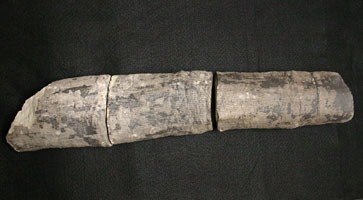Calamites (Annularia, Asterophylites)- meaning reed (also known as giant horsetail), was another of the giants which inhabited the warm damp swamps and marshes that covered the land during the Carboniferous Period. They reached heights of up to 100ft. Can you imagine this fast growing plant reaching a height greater than a ten-story building? Today's surviving species, Equisetum (horsetail), grows to a height of little more than three feet with a diameter of about 1/8th inch. Calamites (horsetails) are characterized by a stiff central stem or trunk with regular intervals of whorls of upswept leaves (similar to inverted umbrellas). They are further characterized by fine vertical ribbing between the transverse bands which showed the old whorl leaf segemnts. They were very successful worldwide, especially along riverbanks, where their bases were frequently buried by shifting sands as they continued to grow. This ability to adapt to its changing environment helped it to support the plant, preventing it from falling over during times of local flooding. Calamites formed spore cones at the end of the growing tip. Spores released from these cones was one of the methods of reproduction used by Calamites along with an underground system of runner-like rhizomes that produced new plants asexually (similar to today's mint plants).
Cross sections of Calamites are rarely found since the center is hollow and once it is laid flat it is generally crushed. Having three sections, in this condition, which articulate is a rare treat. Judging by the size of the left section, when compared to the right section, it was very near the base of the plant.
Specimen is from a private collection and is not currently available for sale!
Calamites 
Quantity in Basket: None
Code: KC-100
Price: $0.00
Shipping Weight: 23.21 pounds
Time: Pennsylvanian (Carboniferous Period), approximately 280 million years ago.
Location: Coal mine, Letcher County, Kentucky, USA.
Dimensions: Left: 6" x 4-1/2" x 3-1/4, Middle: 6-1/4" x 3-3/4" x 3-1/4", Right: 9-5/8" x 4-1/2" x 3-1/4". Total length: 22-1/4".